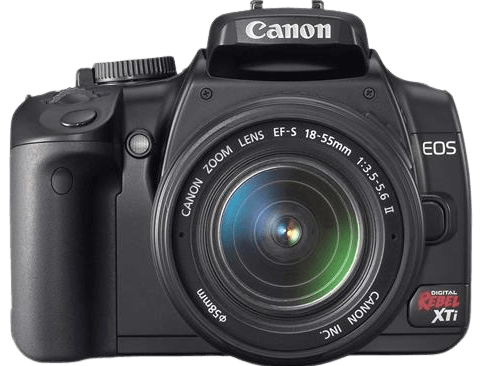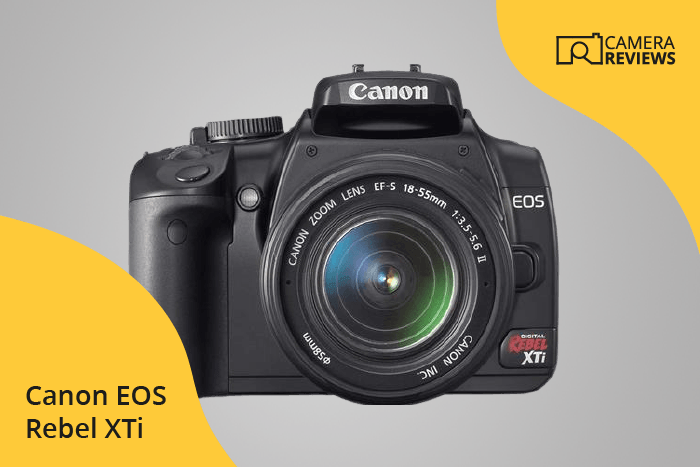Canon EOS Rebel XTi / 400D Specs and Scores

The Canon EOS Rebel XTi / 400D scores a 33/100 in our evaluation, which was announced on August 24, 2006. This DSLR camera measures 127 x 94 x 65mm and weighs 556g (1.23lbs). Launched at a price of $520, its specifications may seem outdated compared to modern cameras.
For anyone confused by Canon camera names, fear not! The Canon EOS Rebel Tti is the American product name. It is called the 40D in Europe, and the Kiss Digital X in Japan. Throughout this article, we’ll mainly refer to it by the American name (Tti).
Despite being released in 2006, the Rebel XTi still offers decent performance for its price. However, today’s market provides more advanced options for both amateurs and professionals. This camera serves as a reminder of how far DSLR technology has progressed over the years.
Canon EOS Rebel XTi Overview and Optics
The optics of the Canon EOS Rebel XTi receive a score of 41 out of 100. This camera features a 10.1-megapixel CMOS sensor, a Digic II processor, and a shooting speed of 3 frames per second. Its DXOMARK sensor score is 62, and it has an APS-C sensor size. The Canon EF-S lens mount allows for a wide range of lens options, but this model does not include image stabilization. The aspect ratio is 3:2.
When compared to current market offerings, the Rebel XTi’s optics may not be as competitive. The 10.1-megapixel sensor and 3 fps shooting speed are below current standards, and the lack of image stabilization could be a drawback for some photographers. However, the camera still has value for those looking for an affordable option with the flexibility of the Canon EF-S lens mount.
The Canon EOS Rebel XTi’s optics may not be the most advanced, but they offer reliable performance and compatibility with a variety of lenses. This camera remains a viable choice for budget-conscious photographers seeking a simple and functional DSLR.
Canon EOS Rebel XTi / 400D Video Performance
The Canon EOS Rebel XTi / 400D lacks video capabilities. This camera only captures still images, not videos.
Canon EOS Rebel XTi Features and Benefits
The Canon EOS Rebel XTi / 400D receives a feature score of 17/100. The camera comes with a 2.5-inch screen size and a screen resolution of 230,000 dots. However, it lacks modern features such as a touchscreen, flip screen, GPS, Wi-Fi, and Bluetooth connectivity.
Considering today’s market, the Canon EOS Rebel XTi falls short when compared to newer cameras with advanced features. Its screen size and resolution are outdated, and the absence of a touchscreen, flip screen, and wireless connectivity options make it less versatile for contemporary photography needs.
The Canon EOS Rebel XTi is a camera that may not meet the expectations of today’s photographers due to its limited features. Its low feature score reflects its inability to compete with modern cameras equipped with advanced specifications.
Canon EOS Rebel XTi Storage and Battery
The Canon EOS Rebel XTi receives a storage and battery score of 21/100. This camera has a single memory card slot, which accepts Compact Flash (Type I or II) cards. In comparison to modern cameras that offer multiple memory card slots and support for SD cards, the storage capacity for the Rebel XTi may seem limited.
Regarding battery life, the Rebel XTi / 400D offers 370 shots per charge, using the NB-2LH battery. This battery life falls short compared to more recent cameras that provide longer-lasting batteries and USB charging capabilities. The lack of USB charging in the Rebel XTi / 400D may also be considered a disadvantage for users who value convenience and portability.
Taking into account the storage and battery specifications, the Canon EOS Rebel XTi / 400D falls behind in today’s competitive camera market. The limited storage options and shorter battery life may deter potential buyers seeking more advanced features and capabilities.
Canon EOS Rebel XTi Alternatives
Do you want to know how the Canon EOS Rebel XTi compares to its competitors? Have a look at the most popular comparisons for this camera below:
- Canon EOS Rebel XTi vs Nikon D300s
- Canon EOS Rebel XTi vs Sony SLT Alpha 55
- Canon EOS 80D vs EOS Rebel XTi
- Canon EOS Rebel SL2 vs EOS Rebel XTi
- Canon EOS Rebel XTi vs Nikon D3500
- Canon EOS 90D vs EOS Rebel XTi
Canon EOS Rebel XTi / 400D FAQ
Does the Canon EOS Rebel XTi Have Built-in Image Stabilization?
The Canon EOS Rebel XTi does not have built-in image stabilization. However, you can use lenses with image stabilization to reduce camera shake effects.
Does the Canon EOS Rebel XTi Support 4K Video Recording?
The Canon EOS Rebel XTi does not support 4K video recording, as it lacks video functionality entirely. It is primarily designed for still photography.
What Size Sensor Does the Canon EOS Rebel XTi Have?
The Canon EOS Rebel XTi features an APS-C sized sensor, which is smaller than a full-frame sensor but still provides good image quality for most photography needs.
Does the Canon EOS Rebel XTi / 400D Have a Dual Memory Card Slot?
No, the Canon EOS Rebel XTi / 400D has only a single memory card slot, which supports CompactFlash (CF) cards.
Does the Canon EOS Rebel XTi Have a Touch Screen?
The Canon EOS Rebel XTi does not have a touch screen. It uses physical buttons and a 2.5-inch LCD screen for menu navigation and image review.
Does the Canon EOS Rebel XTi Have Wi-Fi and Bluetooth?
The Canon EOS Rebel XTi does not have built-in Wi-Fi or Bluetooth capabilities for wireless connectivity or remote control.
Does the Canon EOS Rebel XTi Have GPS?
No, the Canon EOS Rebel XTi does not have built-in GPS functionality for geotagging your photos.
Is the Canon EOS Rebel XTi Weather Sealed?
The Canon EOS Rebel XTi is not weather sealed, so extra care should be taken when using it in harsh weather conditions or wet environments.
Does the Canon EOS Rebel XTi Have a Built-in Flash?
Yes, the Canon EOS Rebel XTi has a built-in pop-up flash, useful for low-light situations or as a fill-flash when needed.

